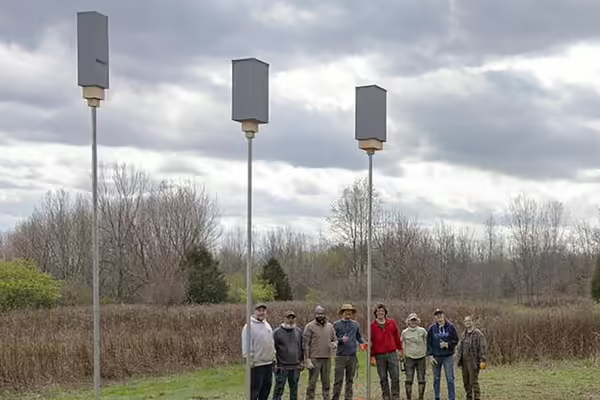
URBANA, Ill. — Imagine moving into a new house just to discover it has no insulation. That’s what life can be like for a bat box resident.
Bat boxes, a kind of artificial roost, are a simple and cost-effective way to increase habitat for these flying mammals. They’re a preferred spot for mother bats to raise pups if their favorite housing option, large dead trees, are hard to come by. But if improperly designed, bat boxes can end up hurting more than helping, Illinois bat researcher Joy O’Keefe says.
O’Keefe is an Illinois Extension wildlife specialist and an associate professor of natural resources and environmental sciences; both units are part of the College of Agriculture, Consumer and Environmental Sciences. In a new Ecological Solutions and Evidence study, O’Keefe, along with Indiana State University colleague George Bakken, leveraged digital simulations to discover that simple insulation changes could make bat boxes much safer.
Bat box design might seem straightforward at first glance. Bats need habitat, and boxes can provide shelter. But the reality is much more complicated, O’Keefe said.
“Bats can’t really evaluate the key characteristics that could dictate how healthy or safe these boxes are,” O’Keefe said. “So it’s incumbent upon us to put out good habitat for them.”
One such important characteristic is temperature. As ambient temperature and sunlight fluctuate throughout the day, bat boxes might get dangerously hot or cold. But bats can’t predict this before choosing the box to roost in, O’Keefe said, and are unlikely to leave boxes during the day due to fear of predation. The results can be deadly, as entire bat families have died in poorly designed boxes.
Improving these boxes is critical as bats face habitat loss and epidemic disease. Midwestern bats are threatened by white nose syndrome, a widespread illness caused by fungal infection, but face an even greater threat from the destruction of forests, where they live.
Read the full release from College of ACES.
University of Illinois Extension develops educational programs, extends knowledge, and builds partnerships to support people, communities, and their environments as part of the state's land-grant institution. Extension serves as the leading public outreach effort for University of Illinois Urbana-Champaign and the College of Agricultural, Consumer and Environmental Sciences in all 102 Illinois counties through a network of 27 multi-county units and over 700 staff statewide. Extension’s mission is responsive to eight strategic priorities — community, economy, environment, food and agriculture, health, partnerships, technology and discovery, and workforce excellence — that are served through six program areas — 4-H youth development, agriculture and agribusiness, community and economic development, family and consumer science, integrated health disparities, and natural resources, environment, and energy.